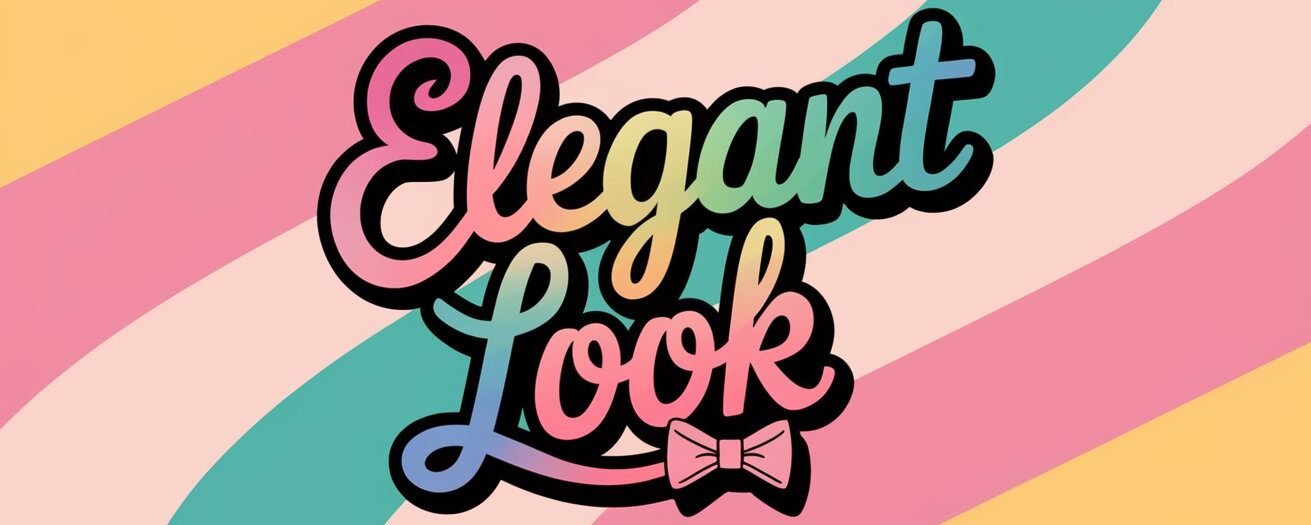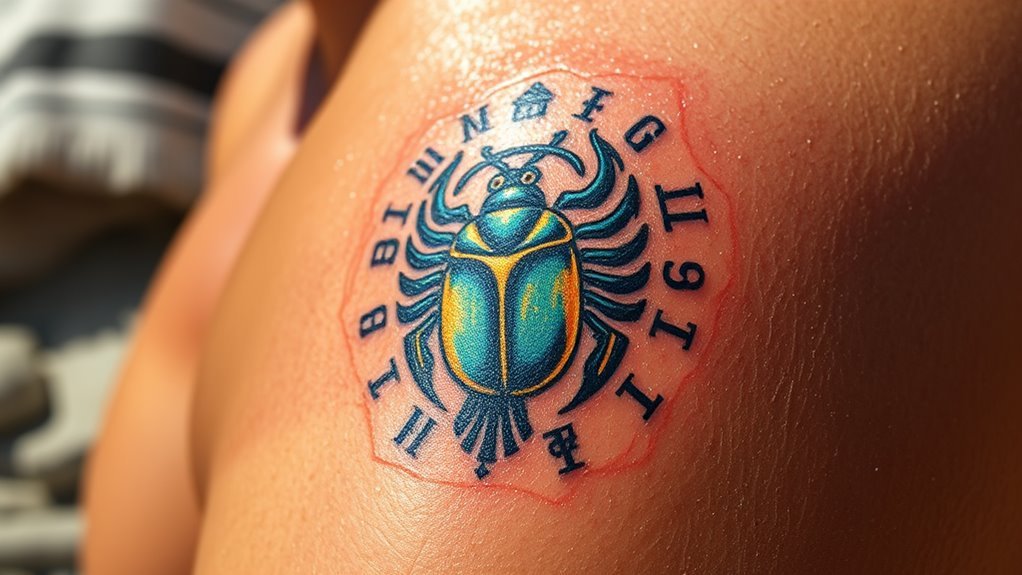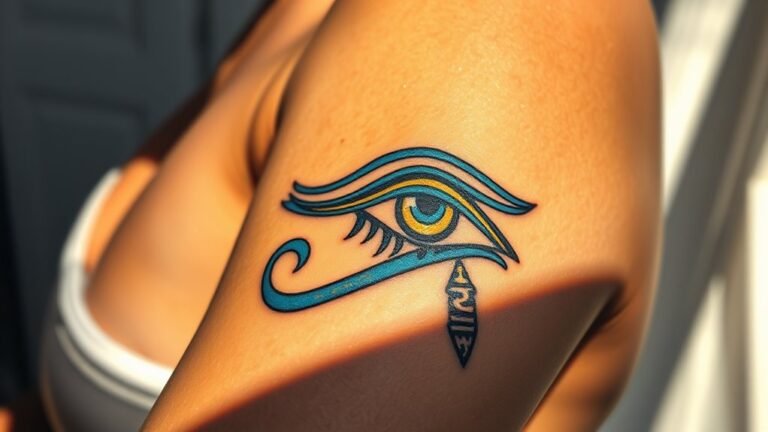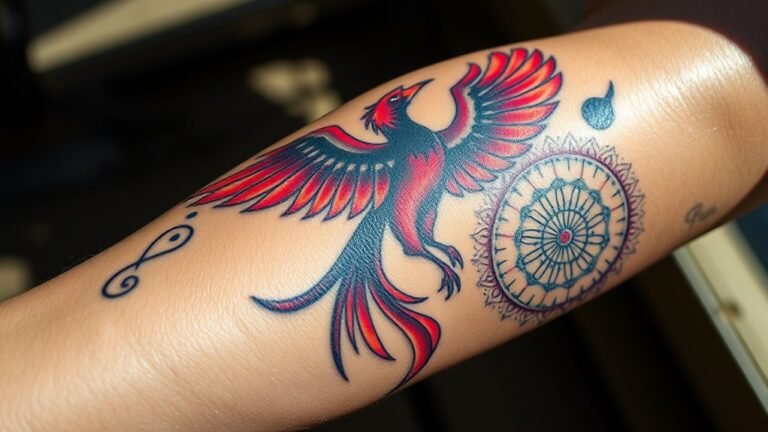Egyptian Tattoo Meaning and Symbolism
When you think about Egyptian tattoos, you might find yourself intrigued by the depth of their meanings and the symbolism they carry. Each design, from the Eye of Horus to the Ankh, tells a unique story that connects you to an ancient culture rich in history. These symbols serve not just as art but as powerful representations of protection, life, and transformation. What does it mean for you personally to wear such an emblem? Understanding the significance behind these tattoos could reveal layers of meaning you hadn't considered before.
In a Nutshell
- Egyptian tattoos often symbolize protection, healing, and power, with designs like the Eye of Horus serving as a safeguard against negativity.
- The Ankh represents immortality and the connection between the physical and spiritual realms, fostering personal expression linked to cultural heritage.
- Scarab beetle tattoos symbolize rebirth and transformation, reflecting the sun's life-giving power and the cyclical nature of life.
- The Lotus flower embodies purity and personal growth, representing beauty that emerges from chaos and encouraging reflection on life's challenges.
- Tattoos of Egyptian gods and goddesses express personal beliefs, seek divine guidance, and connect wearers to a rich cultural and spiritual legacy.
The Eye of Horus
The Eye of Horus, a powerful symbol in ancient Egyptian culture, represents protection, healing, and royal power. When you wear this symbol, you're not just adorning your body; you're embracing Horus symbolism, rooted in a rich legacy of spiritual significance.
This protective charm served as a safeguard against misfortune and a beacon of strength throughout history.
In daily life, ancient Egyptians believed that the Eye of Horus could ward off negativity and bring harmony, making it a cherished emblem for warriors and families alike.
By choosing this design for your tattoo, you connect with a timeless tradition, embodying the essence of protection and resilience.
It's more than ink; it's an invitation to belong to a narrative that transcends time.
Ankh: The Key of Life
Often referred to as the "Key of Life," the Ankh embodies a powerful symbol of immortality and eternal life in ancient Egyptian culture. Its origins trace back to early dynastic Egypt, where it represented the connection between the physical and spiritual domains.
When you explore ankh designs, you'll discover variations that incorporate floral motifs or the scarab, emphasizing rebirth. Wearing an Ankh tattoo can serve as a personal reminder of resilience and the cycle of life, fostering a sense of belonging to a rich cultural heritage.
Scarab Beetle Symbolism
Scarabs roll balls of dung, a behavior that ancient Egyptians linked to the sun's journey across the sky. This connection gave rise to the scarab beetle as a symbol of rebirth and transformation.
You'll find scarab beetle designs in jewelry, amulets, and tattoos, each reflecting the scarab's origins as a sacred creature. The beetle's ability to create life from dung mirrored the sun's ability to bring life to the earth.
When you wear a scarab tattoo, you're not just embracing an aesthetic; you're connecting with a rich cultural heritage that emphasizes renewal and protection. This symbol invites you into a community that values resilience and hope, reminding you of the cyclical nature of life.
The Lotus Flower
Symbolizing purity and rebirth, the lotus flower holds a prominent place in ancient Egyptian culture.
You'll notice its rich lotus symbolism woven throughout Egyptian art, from intricate carvings to vibrant frescoes. The flower rises from muddy waters, representing the idea that beauty can emerge from chaos, a powerful message for those seeking connection and renewal.
When you see the lotus in art, it often appears alongside deities and in funerary scenes, signifying its role in the journey to the afterlife.
This powerful emblem invites you to reflect on your own transformation and growth, encouraging a sense of belonging to a greater cycle of life. Embracing the lotus can inspire you to rise above challenges and embrace your unique path.
Egyptian Gods and Goddesses
Ancient Egyptian culture is rich with a pantheon of gods and goddesses, each embodying different aspects of life, nature, and the cosmos. These deities play an essential role in ancient mythology, representing everything from fertility and the afterlife to wisdom and warfare.
By tattooing symbols of these divine beings, you connect with their attributes, seeking their divine protection in your daily life. For instance, the scarab beetle represents rebirth, while Isis embodies motherhood and healing.
Such tattoos not only express personal beliefs but also create a sense of belonging to a vast cultural heritage. Embracing these symbols can deepen your understanding of life's mysteries and provide a spiritual guide, echoing the ancient Egyptians' reverence for their gods and goddesses.
Hieroglyphs and Their Meanings
While exploring the intricate world of Egyptian tattoos, you'll find that hieroglyphs hold profound significance beyond mere decoration.
These ancient scripts serve as a bridge to understanding the rich cultural influence of ancient Egypt. Each symbol tells a story, representing concepts like life, death, and protection, allowing you to connect with a timeless legacy.
For instance, the ankh symbolizes eternal life, while the Eye of Horus offers protection and healing.
By choosing hieroglyphs for your tattoo, you're not just adorning your body; you're embracing a deeper narrative that resonates with those who share your appreciation for history and spirituality.
This connection fosters a sense of belonging to a culture that has captivated hearts for millennia.
The Significance of Sphinxes
Sphinxes, with their striking blend of human and lion features, have captivated imaginations for centuries. In sphinx mythology, these majestic creatures serve as guardians of sacred spaces, embodying strength and wisdom.
Their symbolism extends beyond mere protection; they represent the balance between human intellect and animal instinct, reminding you of your own duality.
As you explore sphinx imagery in tattoos, you connect with ancient beliefs that emphasize the importance of mystery and knowledge. Many choose sphinx tattoos to signify their personal journey through challenges, embodying resilience and insight.
Frequently Asked Questions
Are Egyptian Tattoos Popular in Modern Tattoo Culture?
You'll find that Egyptian tattoos are increasingly popular in modern tattoo culture. Their ancient symbolism and cultural significance resonate with many, creating a sense of belonging to history and identity that people deeply appreciate today.
How Do I Choose an Egyptian Tattoo Design?
When choosing an Egyptian tattoo design, consider ancient symbols that resonate with you personally. Reflect on their meanings, ensuring they hold personal significance, connecting you to a rich cultural heritage that fosters belonging and identity.
What Are Common Colors Used in Egyptian Tattoos?
When you explore Egyptian tattoos, consider colors like blue, symbolizing creation, and green, representing fertility. These hues carry deep significance, highlighting Egyptian color symbolism and tattoo color significance, fostering a connection to a rich cultural heritage.
Can Egyptian Tattoos Be Combined With Other Styles?
You can definitely combine Egyptian symbols with other styles through tattoo fusion. This blend creates unique art that connects cultures, allowing you to express your identity while honoring diverse traditions and fostering a sense of belonging.
How Should I Care for My Egyptian Tattoo?
To care for your tattoo, follow these aftercare tips: keep it clean, moisturize regularly, and avoid sun exposure. This guarantees a smooth healing process, helping you feel connected to the design's deeper significance and community.







